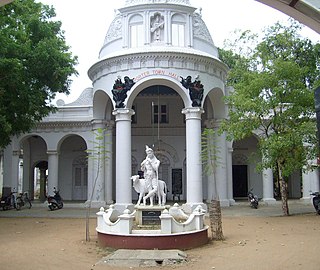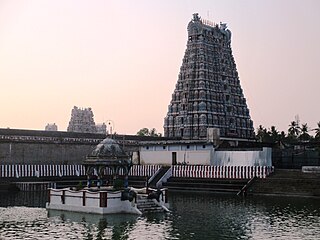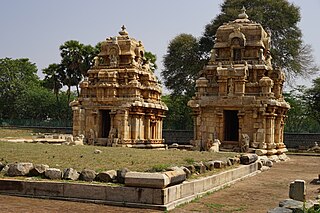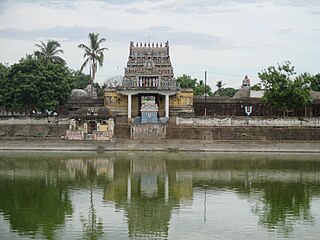Related Research Articles

Kumbakonam is a town and a special grade municipality in the Thanjavur district in the Indian state of Tamil Nadu. It is located 40 km (25 mi) from Thanjavur and 273 km (170 mi) from Chennai and is the headquarters of the Kumbakonam taluk of Thanjavur district. The town is bounded by two rivers, the Kaveri River to the north and Arasalar River to the south. Kumbakonam is known as a "temple town" due to the prevalence of a number of temples here and is noted for its Mahamaham festival which attracts people from all over the country.

Thanjavur, formerly Tanjore, is a city in the Indian state of Tamil Nadu. Thanjavur is an important center of South Indian religion, art, and architecture. Most of the Great Living Chola Temples, which are UNESCO World Heritage Monuments, are located in and around Thanjavur. The foremost among these, the Brihadeeswara Temple, is located in the centre of the city. Thanjavur is also home to Tanjore painting, a painting style unique to the region.

Mannargudi is a town in Tiruvarur district in the Indian state of Tamil Nadu. It is the headquarters of the Mannargudi taluk. The town is located at a distance of 28 km (17 mi) from the district headquarters Tiruvarur, 36 km from Kumbakonam, 40 km from Thanjavur and 310 km (190 mi) from the state capital Chennai. Mannargudi is known for the Rajagopalaswamy temple, a prominent Vaishnavite shrine.

Thiruvarur also spelt as Tiruvarur is a town and municipality in the Indian state of Tamil Nadu. It is the administrative headquarters of Tiruvarur district and Tiruvarur taluk. The town was one of the five traditional capitals of the Chola empire, with one of the emperors of the dynasty, Kulothunga Chola I, having it as his capital. The town is believed to be of significant antiquity and has been ruled, at different times, by the Medieval Cholas, Later Cholas, Later Pandyas, Vijayanagar Empire, Marathas and the British. The town is known for the Thyagaraja temple, and the annual chariot festival held in the month of April. The temple chariot of the Thyagaraja temple, weighing 360 tonnes (790,000 lb) and measuring 96 feet (29 m) tall is the largest temple chariot in Tamil Nadu. Thiruvarur is the birthplace of Tyagaraja, Muthuswami Dikshitar and Syama Sastri, popularly known as the Trinity of Carnatic music of the 18th century CE. Thiruvarur Thiyagarajaa swaamy temple is older than Tanjore big temple.

Needamangalam (Nidamangalam) formerly Yamunambalpuram, is a town panchayat in Thiruvarur district in the Cauvery Delta of Indian state of Tamil Nadu. Needamangalam was originally part of composite Tanjore District during British Raj until 1997 AD. In the 18th and 19th century, it was also called Yamunambalpuram. Needamangalam is the headquarters of the Needamangalam Taluk. The town is located 20 km east of Thanjavur, 80 km east of Tiruchirappalli and 318 km south of Chennai. Needamangalam is a junction for two busy highways, (i) National Highway 67 is a National Highway in Southern Indian states of Tamil Nadu and Karnataka that runs from Nagapattinam, a sea-side town in Tamil Nadu to Gundlupet, Karnataka (ii) State Highway SH-66 connecting Kumbakonam with Adirampattinam via Mannargudi in Cauvery Delta.
Ālvār Sri Parāntakan Sri Kundavai Nachiyar (Tamil: ஆழ்வார் ஸ்ரீ பராந்தகன் ஸ்ரீ குந்தவை நாச்சியார்; born c. 945), better known mononymously as Kundavai, was a princess of the Chola empire who lived in the tenth century in South India. She was the daughter of Parantaka Chola II and the elder sister of Rajaraja Chola I. She was born in Tirukoilur and was the second child of Sundara Chola. She had title as Ilaiyapirātti Kundavai Nachiyar.

Brihadishvara temple, also called Rajarajeswaram or Peruvudaiyār Kōvil, is a Hindu temple dedicated to Shiva located in South bank of Kaveri river in Thanjavur, Tamil Nadu, India. It is one of the largest South Indian temples and an exemplary example of a fully realized Tamil architecture. It is called as Dakshina Meru. Built by Tamil king Raja Raja Chola I between 1003 and 1010 AD, the temple is a part of the UNESCO World Heritage Site known as the "Great Living Chola Temples", along with the Chola dynasty era Gangaikonda Cholapuram temple and Airavatesvara temple that are about 70 kilometres (43 mi) and 40 kilometres (25 mi) to its northeast respectively.

SriVidhya Rajagopalaswamy temple is a Vaishnavite shrine located in the town of Mannargudi, Tamil Nadu, India. The presiding deity is Rajagopalaswamy, a form of Lord Krishna. The temple is spread over an area of 23 acres (93,000 m2) and is one of the important Vaishnavite shrines in India. The temple is called Dakshina Dwarka along with Guruvayoor by Hindus.

Mahalingeswaraswamy Temple, Thiruvidaimarudur is a Hindu temple dedicated to the deity Shiva, located in Tiruvidaimaruthur, a village in the South Indian state of Tamil Nadu. It is significant to the Hindu sect of Saivism as one of the seven major Shiva temples. Shiva is worshiped as Mahalingeswaraswamy, and is represented by the lingam, with his idol referred to as Jothimayalingam. His consort Mookambika is depicted as Pirguchuntarakujambigai. The lingam of the temple is believed to be the focal point for the seven consorts of Shiva. The presiding deity is revered in the 7th century Tamil Saiva canonical work, the Tevaram, written by Tamil poet saints known as the nayanars and classified as Paadal Petra Sthalam. The 9th century Saiva saint poet Manikkavacakar has sung praise about the temple in his works.

Moovar Koil or "The Three temples" is a Hindu temple complex situated in the village of Kodumbalur, 36 kilometres from Pudukkottai in Tamil Nadu, India. These temples were constructed by the Chola feudatory and Irukkuvel chieftain Boothi Vikramakesari as per the inscription. Only two of the three temples have managed to survive. The place was ruled by Irukkuvel chieftains. Kodumbalur was also the site of a fierce battle between the Pandyas and the Pallavas.

Garbharakshambigai Temple is a Hindu temple dedicated to Shiva located in Thirukarukavoor, Tamil Nadu, India. The temple is located 6 km east of Papanasam, 20 km south east of Kumbakonam, 10 km north of Saliyamangalam, 20 km north east of Thanjavur and on the southern bank of Vettar River.

Kayarohanaswami Temple, Nagapattinam is a Hindu temple dedicated to Lord Siva situated in the town of Nagapattinam in Tamil Nadu, India. The presiding deity is known as Kayarohana and his consort is Nilayathakshi. The temple has been in existence from the 6th century AD and has been praised by the Nayanmars Appar, Sambandar and Sundarar. The temple has been constructed by the Lakolisa cult which originated in Gujarat and their only other temple in Tamil Nadu is at Kanchipuram. The idol of Thyagaraja in the temple is made of lapis lazuli.

The Saranathan Temple in Thirucherai, a village in the outskirts of Kumbakonam in the South Indian state of Tamil Nadu, is dedicated to the Hindu god Vishnu. The temple is glorified in the Divya Prabandha, the early medieval Tamil canon of the Azhwar saints from the 6th–9th centuries AD. It is one of the 108 Divyadesam dedicated to Vishnu, who is worshipped as Saranathan and his consort Lakshmi as Saranayaki. It is believed that Saranathan appeared for Cauvery, the river goddess, who performed penance at this place.

Vedaranyeswarar Temple is a Hindu temple dedicated to the god Shiva, located in the town of Vedaranyam in Tamil Nadu, India. Vedaranyeswarar is revered in the 7th century Tamil Shaiva canonical work, the Tevaram, written by Tamil saint poets known as the Nayanars and classified as Paadal Petra Sthalam. It is the only temple to have found mention in all the seven Thirumurais. The temple is famed for the legend between the saints Appar and Sambandar when the former sang to open the door while the latter sang to close the door.

Bhaktavatsala Perumal Temple is a temple dedicated to Hindu god Vishnu, located in Thirukannamangai, a village in Tiruvarur district in the South Indian state of Tamil Nadu. Constructed in Dravidian style of architecture, the temple is glorified in the Divya Prabandha, the early medieval Tamil canon of the Azhwar saints from the 6th–9th centuries AD. It is counted as one among the 108 Divya Desams dedicated to Vishnu. Vishnu is worshipped as Bhaktavatsala Perumal and his consort Lakshmi as Kannamangai Nayagi.
Sevappa Nayak was a governor of Thanjavur under the Vijayanagar Empire who later proclaimed his independence and founded the Thanjavur Nayak kingdom. He reigned from 1532 to 1560.

Nearly 33,000 ancient temples, many at least 800 to 2000 years old, are found scattered all over Tamil Nadu. As per Tamil Nadu Hindu Endowments Board, there are 38,615 temples. Most of the largest Hindu Temples reside here. Studded with complex architecture, variety of sculptures, and rich inscriptions, the temples remain the very essence of the culture and heritage of Tamil land, with historical records dating back to at least 3,000 years.
Sivaganga Palace is a palace in Sivaganga district, Tamil Nadu, southern India, about 40 kilometres (25 mi) from Madurai. It is an old royal palace, with many historical connections. The palace was used as residence by queens Velu Nachiyar (1780–90), Vellacci Nachiyar (1790–93) and Rani Kaathama Nachiar (1864–77). No remains of the original Sivaganga Palace exist, but a new palace, known as "Gowri Vilasam", was built by Padamathur Gowry Vallabha Thevar (1801-1829) in the year 19th century. A heritage site of Chettinad, it was the property of Rani Velu Nachiar.

Gangaikonda Cholapuram temple is a Hindu temple dedicated to Shiva in Gangaikonda Cholapuram, Jayankondam, in the South Indian state of Tamil Nadu. Completed in 1035 AD by Rajendra Chola I as a part of his new capital, this Chola dynasty era temple is similar in design, and has a similar name, as the older 11th century, Brihadeeswarar Temple about 70 kilometres (43 mi) to the southwest in Thanjavur. The Gangaikonda Cholapuram Temple is smaller yet more refined than the Thanjavur Temple. Both are among the largest Shiva temples in South India and examples of Dravidian style temples. The temple is also referred to in texts as Gangaikonda Cholapuram Temple or Gangaikondacholeeswaram Temple

Kabardeeswarar temple is a Hindu temple situated in the village of Thiruvalanchuzhi near Swamimalai in Kumbakonam taluk of Thanjavur district, Tamil Nadu, India. Shiva is worshiped as Kabardeeswarar and is represented by the lingam and his consort Parvati is depicted as Brihannayagi. The presiding deity is revered in the 7th century Tamil Saiva canonical work, the Tevaram, written by Tamil poet saints known as the nayanars and classified as Paadal Petra Sthalam.
References
- Tourist Guide to Tamil Nadu. Chennai: Sura Maps. 2008. ISBN 978-81-7478-177-2.
| Wikimedia Commons has media related to Sivaganga Park . |